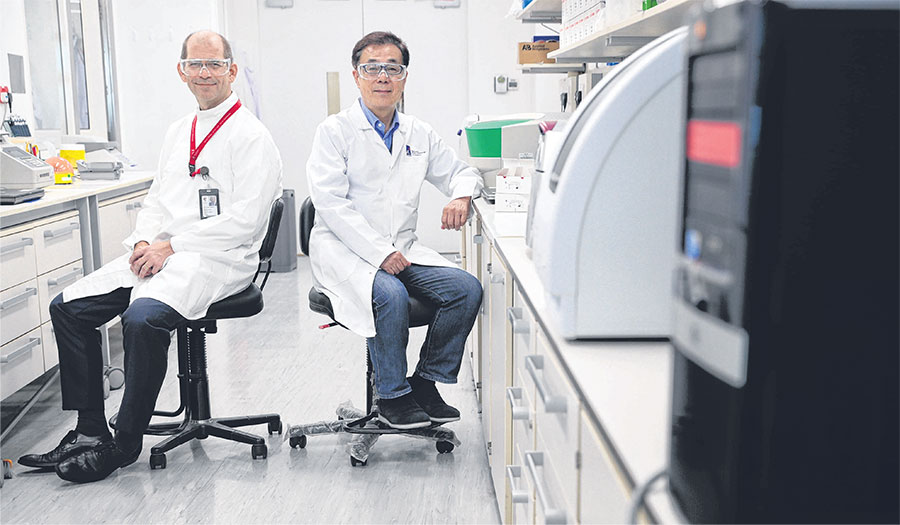
The Straits Times (16 February 2020)
As merrymakers ushered in the dawn of 2020 with high spirits, infectious diseases experts in Singapore were on high alert. Their radars, honed by experience, had picked up on a series of pneumonia- like cases in Wuhan, China.
By the time the Chinese authorities alerted the World Health Organisation on Jan 31 that they had an outbreak of an unknown virus on their hands, scientists here were waiting to spring into action.
On Jan 2, Dr Masafumi Inoue, a scientist at the Agency for Science, Technology and Research (A*Star), sent a text to Dr Timothy Barkham, who works at Tan Tock Seng Hospital (TTSH), saying: “How are you, Tim, how’s your holiday?”
It was not a run-of-the-mill greeting from a friend.
The two infectious diseases experts first met during the severe acute respiratory syndrome (Sars) outbreak in 2003, and over the past 17 years, have collaborated on the development of diagnostic kits for other disease outbreaks, such as the swine and avian influenzas.
In his message, Dr Inoue attached a link to a news report about the pneumonia outbreak in China. Dr Barkham replied: “Lots of noise, but no diagnostic details. Happy New Year.”
The conversation ended with the pair agreeing to meet soon. Dr Barkham, 55, a senior consultant medical microbiologist at TTSH’s department of laboratory medicine, tells Insight: “We are constantly on the lookout for possible new infectious diseases. And we get reports of possible outbreaks all the time. Often, they turn out to be isolated cases, but we are always waiting to see what’s next.”
No one knew what this virus was, how it related to other known viruses, or where it had come from.
With no reported cases in Singapore, there were no patient samples to work with.
But Dr Inoue had a “sixth sense” it would be significant. “Based on what I observed of past events, such as the 2009 swine flu and the 2016 Zika outbreak, I had a hunch,” says the head of the diagnostics group in the translational sciences division of A*Star’s Experimental Drug Development Centre.
On Jan 12, the full genome of the Sars-CoV-2 virus, which causes the disease now known as Covid-19, was uploaded onto a public database.
A virus’ unique genome serves as a “fingerprint” to distinguish it from other viruses.
Once the genome was made available, scientists could determine that the coronavirus was related to the virus that caused the 2003 Sars outbreak which killed almost 800 people.
Scientists from A*Star and TTSH, including Dr Inoue and Dr Barkham, were now able to develop a diagnostic test kit to help clinicians at public hospitals diagnose infections with high accuracy.
Tests for 10,000 patients have also been delivered to China, as part of Singapore’s efforts to help tackle the international outbreak.
To develop the diagnostic test, Dr Inoue’s team first compared the genome of the new virus with that of related viruses, such as Sars, and identified parts of the genetic code that were unique to Sars-CoV-2.
The test flags these unique areas in a process known as polymerase chain reaction (PCR).
The diagnostic test kits were developed and rolled out in less than a month – a record, considering that a similar one for Sars took months – but its speed belied the effort that went into it.
Both men and their teams had many sleepless nights and countless discussions over text messages, e-mail and the occasional beer, to troubleshoot problems, fine-tune the product and overcome challenges such as disruptions in the supply of chemicals needed.
A day after Singapore diagnosed its first coronavirus patient on Jan 23 – a 66 year-old man from Wuhan who had stayed at a hotel on Sentosa – Dr Inoue and Dr Barkham met to discuss the development of the diagnostic kit at – of all places – Sentosa, where a food festival was taking place.
Asked if they had been afraid of getting infected, Dr Inoue says: “No. That’s one important thing to note – that the risk of infection is very low in an open space.”
Dr Barkham says the close synergy between the hospitals and research scientists was crucial in the development of the diagnostic test, and is the result of a close partnership that began in 2003.
He said: “At the hospitals, our aim is to deliver a service to patients.
What may work well in a lab setting may not be that practical in the hospital.
So we have to constantly give each other feedback on how to improve the diagnostic test so it will benefit patients.”
This includes, among other things, being able to try out the diagnostic tests on real human samples, which could have other molecules or compounds that could disrupt the test, giving it false positive or negative readings, he says.
Also, for the readings from the PCR machine to be accurately used by clinicians in diagnosis, both teams worked to optimise them, carrying out the test at different temperatures to see which temperature registered the clearest reading.
Though there can be differences in expectations between scientists who develop the tests and those who implement them, both want the same thing: for the science to benefit the public.
Talks are now ongoing to scale up production of the diagnostic kits for distribution to other hospitals here, says A*Star.
Dr Inoue says it is important for Singapore to develop and manufacture its own diagnostic test kit in a disease outbreak. “We have the technology. And if we develop one ourselves, we won’t be put in a situation where we have to rely on others to help control the outbreak.”